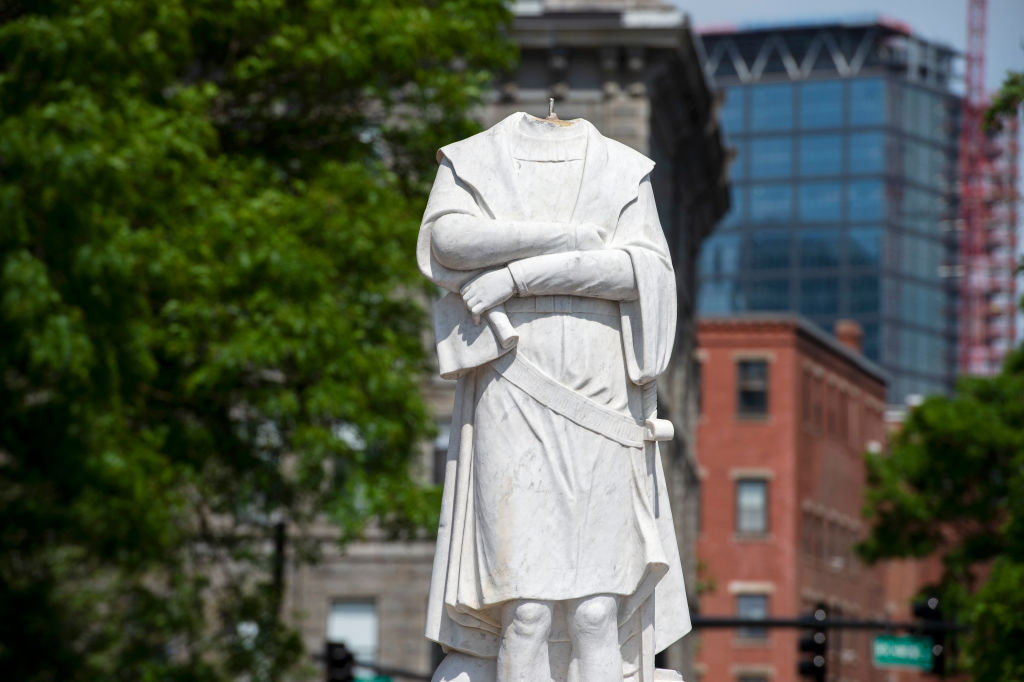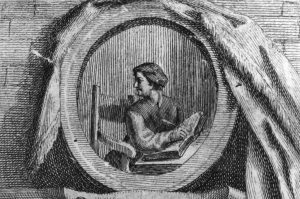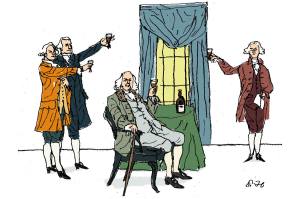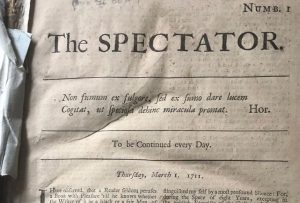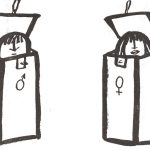The war of the statues is no longer a battle over the memory of slavery, or the Confederacy, or the deployment of stone dead generals to reinforce Jim Crow. It is a battle over the legitimacy of the United States which, despite all the evils, is history’s greatest and possibly final experiment in human freedom.
The struggle has turned from Confederate generals to the Founders: from those who seceded from the United States to those who laid its foundations. Students at the University of Missouri are petitioning for the removal of a statue of ‘racist slave owner’ Thomas Jefferson, whose statue at Birmingham, Alabama was damaged in an arson attack. Last week at George Washington University, Washington’s bust was toppled from its plinth. On Tuesday night, Christopher Columbus was decapitated in effigy in Boston and overturned, vandalized and tipped into a lake in Richmond, Virginia.
Statues, like all monumental architecture, are visible symbols of a political order. This is why their identity and placement matter so much. This is why revolutions begin by attacking symbols: the Virgin and Child, the Bastille, Lenin, Saddam. And this is why pulling down a monument is always a mere prelude to the real action. The iconoclast never stops there. He is clearing the ground for building a new order, as the Taliban smashed the Bamiyan Buddhas and Isis blew up ancient Palmyra.
The power of statues is so great that Moses listed the worship of ‘graven images’ in his top 10 taboos. The history of religion, which turned into the history of politics during the Reformation, is a story of targeted vandalism. The early Christians defaced pagan icons to annul the gods they represented. The conquering Muslims smashed any idols in their path and built mosques on the sites of Jewish, Christian, Hindu and pagan shrines in case old reverence and new challenges sprouted from the spot. This is what’s going on when a bust of Washington is overturned: the attackers want to limit the freedom it might encourage, in order to install anti-democratic codes of speech and behavior.
In the Reformation, Christian ‘reformers’ sacked their own churches, destroyed their common heritage and severed their contact with the higher arts — all because Praise-God Barebones wanted to praise God bare-bones style. In the process, the Puritans introduced ‘iconoclasm’, idol-breaking, into English.
Our culture, which is many ways has secularized Puritan values, praises the ‘iconoclast’. We celebrate Lin-Manuel Miranda for his iconoclastic rap take on Alexander Hamilton. But the real Hamilton fixed slave purchases for his wife’s family. Are we to immolate the scripts and souvenir programs of Hamilton as the Nazis burned books?
‘Écrasez l’infâme,’ Voltaire advised. ‘Crush the loathsome thing.’ He was talking about the Catholic Church before the French Revolution. The history of religion becoming the history of politics, the French Revolution crushed and killed everything it loathed. The people who attack statues of Washington and Jefferson loathe everything about the United States.
The barbarians are not the descendants of the slaves, but the descendants of the masters. They are privileged whites who learnt the script of revolutionary theater in expensive colleges. The statues are proxies for their ultimate target, which is the Constitution and the liberties it endows. So deeply do these spoilt vandals loathe their home and civilization that they seek to erase its ‘original sin’, racism, by erasing the original sinner, Columbus — in order to raise a new order on the ruins.
The Confederate memorials are used as a wedge with which to advance this revolution. So we must separate Columbus from Calhoun, Thomas Jefferson from Jefferson Davis. Columbus and his men killed and enslaved, and Jefferson and Madison owned slaves. This is appalling, but it is also incommensurate to the industrial slavery of the South, and the bigots who tried to undo the outcome of the Civil War.
Nothing is more loathsome in American history than slavery. The erection of statues to Confederate generals in Democratic-run cities across the South in the early 20th century was a symbolic counterpart to Jim Crow and the Klan, a racist restoration in plain sight. The tolerance of the federal authorities was a further abomination. In 1936, President Franklin D. Roosevelt unveiled a statue of Robert E. Lee in Dallas and praised Lee as ‘one of the greatest American Christians and one of our greatest American gentlemen’. Are we to turn over the statues of FDR, who turned the United States into the ‘arsenal of democracy’, or Eisenhower, who launched a racially segregated Army onto the shores of Africa, Italy and France?
Monuments are part of the historical evidence. This is why erasing even the loathsome statues of Confederate generals is an error. Slavery was more than a system of laws, and its legacies endured beyond plantation house museums. The statues of Lee, or Gen. Williams Carter Wickham, whose statue on the campus of Virginia Commonwealth University was this week dragged down with ropes, defaced and urinated upon, record how unwilling whites were to admit their historic responsibility and how they worked to subvert the South’s military defeat. Wickham’s statue was erected in 1891: it is a celebration of the defeat of Reconstruction. If we wreck it or hide it, we remove the evidence of this wickedness from our children’s sight.
[special_offer]
The better response is to alter the meaning of Confederate statues not by destruction but by enrichment: to change the statues from assertions of racial power to evidence of a crime. This can be done by education and school trips, by installing plaques and counter-statues and other artworks on site, and – after the consent of the voters has been obtained — moving statues into museums.
We owe the past a fair reckoning. We also owe the future a fair chance at arriving at its own reckoning. If we simply destroy the evidence, we impoverish our heirs’ understanding. Jefferson was wrong to own slaves, and he was wrong when he told Madison that the Earth ‘belongs in usufruct always to the living: that the dead have neither powers nor rights over it’.
There can be no usufruct if the living destroy the soil and plant the seeds of evil. Society, Edmund Burke said, is ‘a partnership of the dead, the living and the unborn’. We owe it to the dead and the unborn to tell the truth through the Confederate statues, and to tell the truth about Jefferson’s feet of clay. For the same reason, we also owe it to the dead and the unborn to protect the symbols of liberty. If we fail, other, illiberal symbols will be installed in their places.
